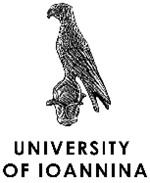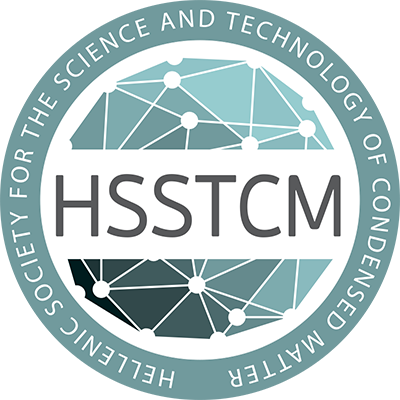

 |
Department of Materials Science and Engineering, University of Ioannina www.materials.uoi.gr | Hellenic Society for the Science and Technology of Condensed Matter www.hsstcm.eu |  |
Department of Physics, Aristotle University of Thessaloniki
The percolation model, together with the Ising model, offer some simple models in Statistical Physics. Τhe made is made of two species (0 and 1), randomly mixed with a prescribed ratio, p, of the two species. By varying p, it is shown that the system undergoes a phase transition of the 2nd order, exhibiting critical behavior, with a critical threshold, critical exponents, etc. We will show how such a system is structured and how it is computationally tractable, since in several cases the values of the critical parameters can only be computed numerically. All parameters depend strongly on the dimensionality of the system, as well as if the system is cast with the encompassing units being the system sites or the system bonds. Smart algorithms have been devised to estimate the critical behavior parameters, since the inherent randomness of the system requires a disproportionate amount of computer time to attack the problem directly. These will be explained in detail since such algorithms offer an example of how one can circumvent the use of brute force in solving a given problem. Finally, an application will be given on how percolation can be used to model the environment around a cancerous tumor, where the concentration of important elements, such as oxygen and the ensuing hypoxia, play a crucial role in the effectiveness of well-known therapies, such as radiation therapies, which are not completely effective even today.
Department of Chemistry, University of Ioannina
The complex behavior of water has motivated the scientific community to develop novel theories and methodologies to provide deeper insight into the molecular causes of its anomalies compared to most liquids. A molecular understanding of the water properties is crucial in numerous processes in chemistry, physics, geosciences, biology, and life evolution. Despite long-lasting research efforts, new intriguing properties are still being described and even the phase diagram of water, although systematically explored in the past, is far from being complete. From a theoretical point of view, the investigation of these characteristic structural features of water and the temperature and pressure effects upon them could be achieved by employing multi-scale modeling techniques, ranging from classical or ab initio molecular simulation techniques to coarse-graining methods. In the framework of the present lecture, recent theoretical advances on this field, aiming to shed light on the unique structural features of water at ambient-pressure liquid up to extreme-pressure supercritical conditions, will be systematically presented and discussed.
Biomedical Research Foundation, Academy of Athens
The increasing applications of nanotechnology in medicine rely on the fact that engineered nanomaterials, such as diagnostic and therapeutic nanoparticles, are able to translocate across the cellular membrane and reach their site of action without toxic effects. One of the first steps into assessing the NP cytotoxicity requires a thorough understanding of the nanoparticle-membrane interaction mechanism, which can be addressed with computer simulations. We use computational approaches for the construction of functionalized magnetite MNPs of different shape, size, and surface chemistry and describe the development of NanoCrystal, a web-based crystallographic tool that creates nanoparticle models from any crystal structure guided by their preferred equilibrium shape under standard conditions according to the Wulff morphology (crystal habit) [1,2]. Subsequently, another algorithm is developed to attach ligands on the MNP core. We have applied these tools for the construction of magnetite nanoparticles coated with polyvinyl alcohol or polyarabic acid and performed Molecular Dynamics (MD) simulations to investigate the MNP in contact with a model cell membrane [3]. In another approach, we use coarse-grained MD to investigate the partitioning of an anionic, ligand-decorated NP in model membranes containing cholesterol [ 4-6]. Simulations reveal that the hydrophobic and hydrophilic ligands of the NP surface rearrange to form optimal contacts with the lipid bilayer, leading to the so-called snorkeling effect. Inside cholesterol-containing bilayers, the NP induces rearrangement of the structure of the lipid bilayer in its vicinity from the liquid-ordered to the liquid phase spanning a distance almost twice its core radius. When several anionic, ligand-coated NPs are embedded in the model membrane, NPs tend to form linear clusters, or chains. Analysis of the driving forces for this association reveals an important role of the recently discovered orderphobic effect.
Department of Materials Science, University of Patras
Soon after the initial discovery and the first experimental studies of two-dimensional graphene sheets, the exceptional electronic, mechanical and thermal properties of this material became apparent. We examine how molecular dynamics simulations can be used to investigate the mechanical behavior and the phonon properties of graphene. We start with the development of appropriate force fields describing the interactions of carbon atoms in graphene, based on accurate quantum mechanical calculations from first principles methods, which can be effectively used in atomistic simulations. Then we discuss the mechanical response and the elastic properties of graphene, as well as of graphene nanoribbons, under uniaxial tensile or compressive strain. At the end we present a method to calculate the phonon dispersion relations of graphene and their dependence on temperature or strain, using molecular dynamics.
Theoretical & Physical Chemistry Institute National Hellenic Research Foundation Athens, Greece
Molecular simulations provide a very useful tool for the exploration and the understanding of the properties of various materials. Application of these techniques however, is not always straightforward when a broad range of length and time scales characterizes the materials under investigation. One example of such systems is the polymers which exhibit length scales ranging from ~Å up to ~ tens of nm and corresponding time scales ranging from a few femtoseconds up to the order of milliseconds or even seconds. Another case is that of bio-inspired materials, where one of the main challenges is to develop a fundamental understanding of biological structures and their self-assembly mechanisms and consequently to engineer innovative biobased materials for a wide range of applications. However, supramolecular structures, which are frequent in all living systems, may range from bimolecular receptor–ligand complexes in the nanometer scale, to macroscopic, self-assembled fibrils such as silk and amyloid fibers that are responsible for major human disorders. Furthermore nanocomposites, which have been widely used both in polymeric systems and in biomedical fields, constitute an additional degree of complexity. For a better exploitation of the various nanotechnology applications, it is necessary to understand the detailed structure-properties relationships of these complex systems. Therefore there is a very broad range of spatiotemporal scales, which need to be probed in order to predict macroscopic properties directly from the monomeric structure. To address this challenge, complementary to experimental methods, simulation methodologies, across various scales, are valuable tools for the guidance and/or the support of the rational design of these materials in the laboratory. Our approach is the development of a computational platform based on systematic hierarchical techniques that involve microscopic (all-atom Molecular Dynamics, MD) and mesoscopic (coarse-grained, CG) simulations as well as mathematical approaches in a consistent way. Multi-scale simulation methods combine atomistic and CG simulations and allow quantitative predictions of various properties (i.e., structural, dynamical, mechanical, etc.) of such complex systems at realistic length and time scales.
Computational & Data Sciences Department, George Mason University (GMU)
The discovery of high critical temperature Tc superconductivity in highly compressed SH3 has been followed by near room temperature superconductivity due to strong electron-phonon coupling in other hydrides such as LaH10 and CaH6. In this work, we performed linearized augmented plane wave (LAPW) calculations for many different volumes in the Im3m structure for XH3 (X=As,Se,Br,Sb,Te and I)as well as in LaH10 and CaH6. We then applied the multiple scattering-based theory of Gaspari and Gyorffy to obtain the Hopfield parameters and the McMillan-Dynes theory to calculate $\lamda$ and $T_c$. Based on our analysis, all considered materials share similar trends of $T_c$ enhancement under increasing pressure. We also present results for LaH10 and CaH6 in which the transition temperature approaches room temperature again at high pressures. Finally, we discuss a tight-binding parametrization for SH3.
Department of Physics, National and Kapodistrian University of Athens
Topologically protected transport has recently emerged as an effective means to address a recurring problem hampering the field of 'slow light' for the past two decades: its keen sensitivity to disorders and structural imperfections [1]. With it, there has been renewed interest in efforts to overcome the delay-time-bandwidth limitation [2] usually characterizing slow-light devices, on occasion thought to be a fundamental limit. What exactly is this limit, and what does it imply? Can it be overcome? If yes, how could topological 'rainbow trapping' [3-5] help, and in what systems? What applications might be expected by overcoming the limit? Our talk will attempt to address these and other related questions while pointing to important new functionalities, both for classical and quantum devices, that overcoming the limit can enable.
Department of Mathematics and Applied Mathematics, University of Crete
We will study a model for the type of exchange interaction that gives antiferromagnetic (AFM) order. It has been known for long that many materials present such order but efforts for their study were hampered by the d ifficulty in observations due to the lack of a generated magnetic field. The situation is changing in the last years as experimental techniques become available that allow for observations down to a few nanometer scale. We will initially review the description of atomic magnetic moments, the magnetic energy, and the equation of motion in the discrete (lattice) system. The order parameter for the description of an antiferromagnet in the continuum approximation will be defined and we will subsequently derive systematically the equations of motion. This is found to be an extension of the, so-called, sigma model that was originally employed and studied in high-energy physics. Fundamental solutions of the model will be presented such as an antiferromagnetic domain wall in its static and propagating form. The dynamics within the sigma model is dramatically different than in the case of ferromagnets (which has been extensively studied experimentally). It gives a richer variety of dynamical behaviours, much faster speeds of propagating solitons, and THz frequencies for magnetic oscillations. In the final part, the numerical simulation of the model will be discussed and we will present ideas about an efficient formulation of the numerical algorithm inspired from the derivation of the continuum model.
Department of Materials Science and Engineering, University of Ioannina
Computational Materials Science is a relatively new and rapidly evolving discipline that brings together elements from materials science, engineering, mathematics, physics, chemistry and computer science. Simulation methods operating on length scales from the molecular to the continuum scale will be discussed. Representative "computer experiment" examples for different categories of materials in the context of basic science and engineering applications will be given.
Webpage credits: Ioannis Remediakis and Niki Sorogas